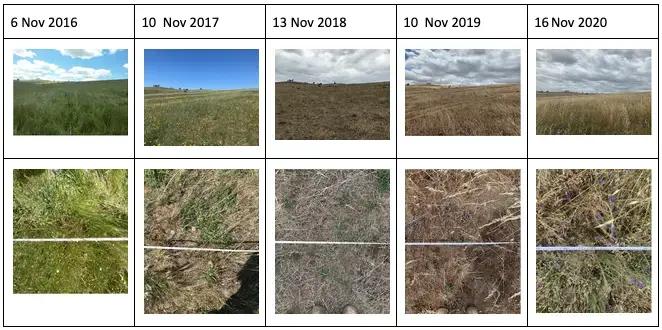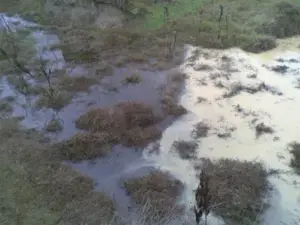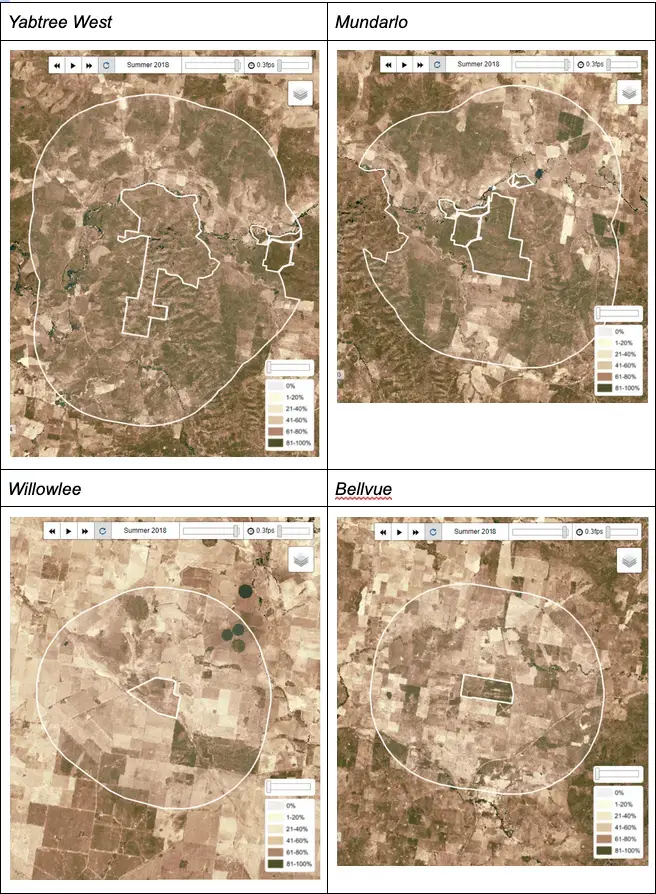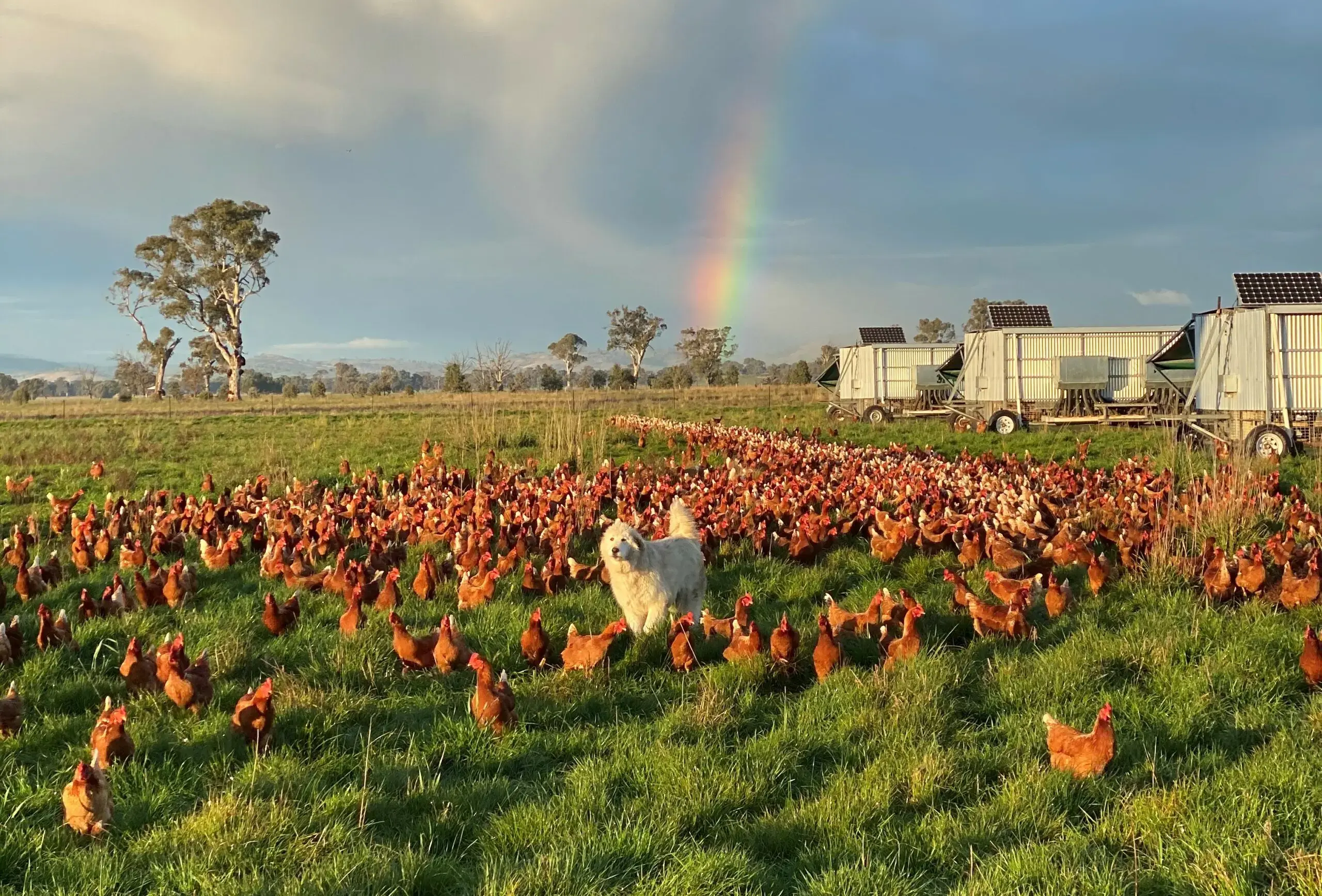Practices and outcomes
Delve deeper into:
• The 8 families’ soil and landscape regeneration practices, and the resulting improvements in landscape function
• Broader outcomes for animal health, economics and well-being.
This section summarises key points from all 8 families. Further detail is available in the focus producer case studies.
Practices to regenerate soils and landscapes
The 8 families have achieved impressive outcomes across their properties. Based on best available data from various monitoring approaches, this section describes practices and outcomes according to four landscape processes that producers can observe and improve1 These landscape processes cover four of the five processes described by Charles Massy in ‘The Call of the Reed Warbler’, which are in turn adapted from a wide range of literature
- Solar-energy cycle: Focused on capturing and maximising solar energy via plants (photosynthesis), and converting this energy to sugars using carbon drawn from the atmosphere. It also includes the cycling and storage of carbon in and out of soil, plants, and animals.
- Water cycle: Describes the cycling of water in the landscape including soil water infiltration, storage and retention, runoff, replenishing water bodies (above and belowground), rainfall, transpiration and evaporation.
- Soil-mineral cycle: Also follows a cyclical pattern as nutrients move through the various organisms in the landscape both above and below ground. Nutrient cycling and availability in the soil, for plant growth and animal growth and health are crucial concepts. This is tightly linked to the other landscape functions – relying on living organisms and water and energy cycles.
- Community (ecosystem) dynamics: Focuses on the diversity required in a healthy functioning ecosystem. This includes inter-dependence of the range of species, including symbiotic relationships and a focus on collaboration rather than competition.
A fifth landscape process – human and social dynamics – focuses on the farmers’ understanding of their own relationship and interaction with the landscape and with their families, groups and local communities. This is discussed in the Broader Outcomes section.
Grazing management (and supporting water infrastructure) is practiced by all 8 families. It can have positive impacts across all four landscape dynamics.
Monitoring and data
The landscape changes described in this section are based on best available data from various monitoring approaches, including structured soil monitoring, in-field ecological assessments and laboratory tests. Several members of the group are undertaking Ecological Outcome Verification™ (EOV). The families also use ‘barefoot monitoring’, where they get out and directly observe changes on their property.
While this monitoring is a good start, some members also recognise the need to refine their measurement approaches through, for example:
-
Developing more structured monitoring plans
-
Improving consistency by using the same laboratory and tests on a recurring basis
-
Using analysis that is suited to the range of different soil types on a property
Monitoring carbon and organic matter is very important for the 8 families, and they will continue to seek practices to improve their knowledge of changes in these landscape dynamics.
It is also important to note that the families have experienced many challenges along the way, and they have had to be open to learning from failure.
Grazing Management
An overarching soil and landscape stewardship practice
Grazing management and supporting water infrastructure can have positive impacts across all four landscape dynamics.
Putting into practice their Holistic Management, Holistic Planned Grazing principles, and RCS grazing for profit training, all of the 8 families undertake time-controlled grazing – more intense grazing complemented by much longer rest periods. This principle then often translates into needing many smaller paddocks with more watering points. In the first couple of years, many of the farmers spent time and money on reducing paddock sizes. For example, Gill at Bibbaringa increased her 23 paddocks to over 80.
Willowlee, Bibbaringa and Spring Creek use the grazing planning system Maia Grazing to plan, track and adjust their grazing locations and stocking rates. Maia Grazing allows them to determine the optimum stocking rate, considering rainfall, pasture history, feed demand, cost of irrigation and other variables.
Two families are using bi-species grazing as part of their soil stewardship practice. At Mundarlo, sheep and cattle graze together – in a ‘flerd’. The sheep and cattle behaviours at this farm are complementary, in that the sheep prefer the higher ground, while cattle prefer the lower ground, and the two species drink water at different times of the day, so shared access to water points is not an issue. On Bellevue, the grazing system incorporates paddock chickens that are rotated around the property in a portable shed. Generally the chickens will follow the cattle, as chicken wellbeing is improved in shorter grass, and the chickens can further distribute the nutrients of the cattle to stimulate the soil, solar and biodiversity landscape functions.
In order to support the intensive grazing of cattle in smaller paddocks over shorter periods of time across the property, water infrastructure was needed for all of the farms. Setting up water infrastructure required considerable forethought and in some cases irrigation specialists to help answer the questions: How can we support optimum flow rate? How can we build on existing irrigation infrastructure? How can we ensure water to all of the smaller paddocks of the rotation grazing system?
Like all decisions made by the 8 families, the decision to install water infrastructure was run through the Holistic Management decision-making framework. Rebecca Gorman (Yabtree West) identified in her Holistic Context, that she was looking for the smooth running of things, meaning she wanted the infrastructure to be simple and easy to use and ‘not a lot of maintenance and mucking around’. So, she decided to put in a good quality watering system at the very beginning, to set herself up for smooth operation into the future. At Willowlee, infrastructure was installed incrementally for financial reasons.
Grazing management and supporting water infrastructure can have the following positive impacts across the four landscape processes:
- Solar-energy: Increased groundcover resulting from grazing management means maximisation and better utilisation of photosynthesis, better above- and below-ground interactions, and greater root mass and biological activity to increase organic matter and carbon.
- Water: Increased groundcover also means better soil structure, which improves water infiltration and storage capacity.
- Soil-mineral: Grazing also provides animal-based fertiliser through dung, and stimulates soil biological activity to aid mineral cycling.
- Community dynamics: With increased water infiltration, nutrients, and plant growth resulting from long resting periods, biodiversity improves, both above and below ground.
Solar-energy cycle
Practices
The 8 families are all working to strengthen the solar-energy cycle. Primary practices implemented to improve the capture of the sun’s energy are through grazing management, resting paddocks in order to enable plants to build energy stores, increasing perennial species, and increasing overall pasture diversity. Different perennials, annuals, and summer annuals all have unique growth cycles and capture solar energy in different ways and at different times, which can improve overall capture of solar energy.
Outcomes
The 8 families see green grass and photosynthesis as powerful drivers of landscape regeneration. All have observed increases in ground cover since making practice changes on their properties. In support of their own observations, spatial mapping indicates the properties have generally shown increased levels of groundcover under their management in drier periods and generally maintained comparatively higher ground cover than the 5km radius surrounding their properties. When compared to surrounding areas, the 8 family properties consistently have less bare ground in all seasons, more ground cover in summer conditions, and maintain ground cover longer in dry conditions.
Increased ground cover provides greater resilience to drought. Even though ground cover generally decreased during the 2018/19 drought, the 8 families maintained more ground cover than surrounding areas during this time.

Nick Austin at Mundarlo has been taking photos every November since 2016 at the same location. The photos show that while the drought did have an impact, the fields continued to have reasonable ground cover throughout.
One 8 families member, Nick at Mundarlo, has been taking photos every November since 2016 at the same location. The photos show that while the 2018/2019 drought did have an impact, the fields continued to have reasonable ground cover throughout.
Water cycle
Practices
The 8 families all aim to slow water movement across the landscape and increase the storage of water in the soil. Several members use Natural Sequence Farming techniques, and integrate this with Holistic Management grazing. The practices include:
- Integrating water contours with grazing cells to improve ground cover (Yabtree West)
- Creating water contours, leaky weirs, redesigning dams, planting over 70,000 trees (Bibbaringa)
- Fencing waterways (Mundarlo)
Outcomes
The 8 families have all observed changes that indicate they have succeeded in slowing the water movement across the land, and stored more water in the soil. They see far less erosion, less runoff and creeks running clear.

Garretts creek Junction, left water following form Mundarlo, Right water flowing from neighbouring areas.
Improvements in water cycles means improvements in other important landscape processes. Rebecca observed links between greater soil water infiltration, soil function and biodiversity. Michael notes that improvements in water cycles have led to improved ground cover, showing the interconnectedness between improving solar and water cycles. The 8 families also appreciate the greater resilience a rehydrated landscape provides against drought. The four focus farms studied in more detail showed lower bare ground than the surrounding area during the drought.

Ground cover percentage over summer 2018- 2019 (vegmachine, 2021).
An important corollary of improved land rehydration is that dams may take longer to fill. However, it is expected that eventually the water stored in the soil will keep dams filled over a longer period of time.
Soil-mineral cycle
Practices
Previous land use on some of the 8 families properties had led to soil compaction and development of clay pans. On some properties – like Bellvue – sensitive soils are particularly prone to erosion and dryland salinity when vegetation is removed.
The primary practice of grazing management with cattle, sheep and chickens is a key factor in improving soil-mineral cycles. Grazing management spreads natural fertiliser in the form of animal dung, improving the soil chemistry and importantly stimulating soil biology. This can stimulate growth of long-rooted perennials, which also improves soil-mineral cycles. Grazing management and Natural Sequence Farming also decrease erosion, and thus keep soil nutrients on the land.
At Willowlee, Michael Gooden is also experimenting with multi-species cropping on irrigation country to improve grazing capacity. The crop is sown directly into the pasture at Willowlee in a ‘no kill’ approach. Not only does multi-species cropping allow more grazes of the paddock (leading to an economic yield), but there are also important soil-mineral implications. The mixed species cover crops have large rhizomes (such as Tillage radish) that aerate the soils, and the legumes fix nitrogen. In addition, a greater diversity of plant species will generally stimulate a broader range of soil biological activity. Michael is also interested in using biological innoculants on the seeds to stimulate fungal growth in the soil.
Outcomes
The 8 families have all observed gradual improvements in pastures, groundcover and soils. They’ve also observed increases in soil macrobiota, such as earthworms, and improvements in the physical properties of the soil. Many also report that the soil feels different. One of the farmers is a runner, and notices the new ‘bounce’ of his soils as he goes for a run on his property. The farmers can also see the difference in vegetation where some of the practices have been implemented:
“We were getting higher succession grasses back in the areas where the chooks had been. That spring, the colour of the grass was just amazing. The volume was chalk and cheeses to where the chooks hadn’t been”
Sam Pincott (Bellvue)
Many of the families are undertaking – or investigating – soil testing to validate these observations.
Community (ecosystem) dynamics
Practices
Many of the practices for improving solar-energy, water, and soil-mineral dynamics undertaken by the 8 families also contribute to increases in biodiversity and overall community health. For example, tree-planting, fencing wetlands to keep stock out, or spreading of animal nutrients in nutrient poor areas, and grazing management (both for recovery periods for natives plants and the eating of invasive plants) were all expected to have a positive impact on pasture diversity.
Trees, as a type of ‘keystone’ element in landscape, can be a particularly helpful practice to improve biodiversity. At Yabtree West, seeds are collected, potted up and propagated to plant out across the property. These plantings are seen an investment in the future.
A Pincott, extensive tree plantings were done with support from Bushlink and Landcare, with the specific intention of increasing biodiversity. Planted around the edge of the property, these trees and shrubs not only created a helpful back-up boundary line in addition to their fence, but also provided shading for chickens and native birds.
Another practice is avoiding spraying with herbicide, recognising the high costs and potential negative flow-on effects for biodiversity. Instead, another – albeit slower – practice is to use cattle to graze weeds in the plants’ ‘high protein’ growth cycle:
“Over the first 12 months a lot of the property had fleabane…I copped a fair bit of flack behind my back for not spraying it out..Surprisingly the cattle loved it because at a certain point in it’s growth cycle, it’s really high in protein. So the cattle were busting to get into those paddocks when they could…running chooks over … high successions came in pretty quickly.”
Sam Pincott (Bellvue)
Reading the landscape and understanding the ecology of different parts of the property is also vital for ensuring healthy, diverse community dynamics. For example, at Willowlee flood plain paddocks are managed far less intensely than the irrigated pasture and other areas of the property. Instead, flood plain paddocks have a 110-120 day recovery, only tend to be grazed in the summer for shade and cooling and watering points.
Outcomes
The 8 families have all witnessed improvements of biodiversity on their land. Management practices have resulted in increased native summer perennials, wild flowers and orchids. These flowers are now spreading out into other areas of the property acting as a seed bank. Saplings are establishing in new areas, and there is evidence of tree succession around creek areas, where there are trees of multiple ages, including trees with hollows. Biological monitoring of pasture species has shown increases in species diversity. More native animals are returning.
“With the long recoveries that we give, the grass is so high that we’re seeing quails nesting in the grasses.”
Rebecca Gorman (Yabtree West)
Importantly, these increases in diversity assist in weed management. The Pincotts are a good example. When they first bought the property, there were lots of Thistles, Capeweed and Paterson’s Curse, but because of their management practices, the growth of desirable grasses has now overtaken and these weeds have all but gone.
-
Animal health
-
Economic position
-
Social wellbeing

This project is supported by the Department of Water, Agriculture and the Environment, through funding from the Australian Government’s National Landcare Program.






